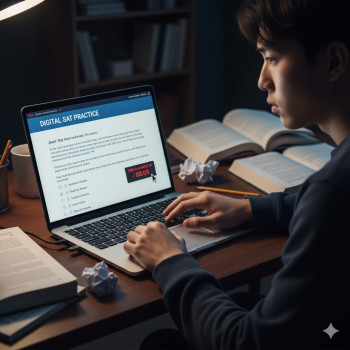Why posture matters when prepping for the Digital SAT
When you’re deep into a practice block of digital SAT questions, the clock on the screen seems to both race and crawl. You’re solving problems, tracking time, and trying to keep your brain sharp for hours. What a lot of students overlook is that your body—especially your spine, neck, and shoulders—plays a huge role in how well your brain performs over long sessions.
Good posture isn’t only about appearances. It influences breathing efficiency, blood flow, muscle fatigue, focus, and even mood. Slouching or craning your neck can lead to headaches, sore shoulders, and that mid-study slump where motivation evaporates. Fixing posture is low-hassle but high-impact: small adjustments can protect your body now and keep you energized as the test approaches.
How study posture affects attention and stamina
Think of your body as part of your study system. When your body is comfortable and aligned, it uses less energy just to hold a position—leaving more resources for concentration and problem solving. When your posture is poor, your muscles work inefficiently. That tension becomes a constant, subtle distraction that chips away at cognitive bandwidth.
Practical effects you may notice when posture suffers during long Digital SAT practice:
- Shorter focus windows and more frequent mental drift.
- Increased physical discomfort leading to more breaks (and often unstructured scrolling breaks).
- Headaches or neck pain that reduce reading speed and comprehension.
- Shallow breathing that lowers oxygen intake, making you feel foggy.
Quick posture checklist before every study session
Before you start a timed section or a long practice session, run this quick 60-second checklist. It only takes a minute, and it sets up a much more productive hour (or two):
- Sit with both feet flat on the floor and knees at about a 90-degree angle.
- Hips should be slightly higher than knees if possible—add a cushion under your hips if your chair is too low.
- Keep your back against the chair or use a small lumbar roll to support the natural curve of your lower back.
- Shoulders relaxed and slightly back, not rounded forward.
- Head balanced over your shoulders—ears roughly aligned with your shoulders, chin slightly tucked.
- Screen (tablet or laptop) at or slightly below eye level so you don’t tilt your head down for long periods.
Setup tip
If you’re taking many of your practice sections on a tablet or laptop for Digital SAT prep, a stand and an external keyboard (or a comfortable lap desk) are tiny investments that pay off every study session. They help keep your screen at eye level while your hands remain in a comfortable typing position.
Designing an ergonomic study environment
Ergonomics is a big word—but when you break it down for students, it’s simply the practice of arranging your study tools so your body feels natural and relaxed. You don’t need a fancy office or an expensive chair to make this work.
Essentials for a student-friendly ergonomic setup
- Chair: firm seat, good back support, and a height that lets feet rest flat on the floor.
- Desk height: forearms should be roughly parallel to the floor when typing or using a calculator.
- Screen distance: roughly arm’s length away; adjust so you can read comfortably without leaning forward.
- Lighting: soft ambient light plus a direct task light for reading to avoid leaning closer to see.
- Accessories: a cushion for lower back support and a small footrest (or a stack of books) if needed.
Table: Ideal ergonomic measurements for students
| Body area | Ideal position/measurement | Why it matters |
|---|---|---|
| Feet | Flat on floor, hips 90–110° above knees | Stability and reduced lower back strain |
| Knees | Level with or slightly lower than hips | Promotes healthy spine alignment |
| Back | Supported lumbar curve | Reduces fatigue during long study blocks |
| Screen height | Top of screen at eye level or slightly below | Prevents forward head posture |
| Arms/wrists | Forearms parallel to floor; neutral wrists | Prevents repetitive strain and improves speed |
Micro-breaks and movement strategies that actually work
Everyone says “take breaks,” but the trick is structuring them so they restore focus and posture rather than letting you spiral into distraction. Here are movement-friendly micro-break patterns that integrate well with Digital SAT practice:
Pomodoro-style with posture focus
- 50–60 minute focused study block (simulate a longer Digital SAT practice section if needed).
- 5–10 minute posture + movement break: stand, shake out your arms, roll your shoulders, do two deep breaths, and perform one of the short stretches below.
- Every 2–3 blocks, take a 20–30 minute break for a brisk walk or light exercise to restore circulation and reset posture.
Three simple stretches you can do at your desk
- Chest opener: clasp hands behind your back, straighten your arms, lift your chest gently and breathe for 20–30 seconds.
- Neck mobility: slowly tilt your ear to shoulder, roll the chin down and around to the other side—repeat 3–4 times each side.
- Seated hip opener: cross one ankle over the opposite knee and lean forward gently for 20–30 seconds to relieve low-back tension.
Breathing and micro-postural habits to boost clarity
Posture and breathing are cousins: improved alignment makes it easier to take full, diaphragmatic breaths. When you breathe better, you maintain steady oxygenation of the brain, reduce anxiety, and can sustain concentration longer—essential for long SAT practice sessions.
Two-minute breathing routine to reset focus
- Sit upright, hands resting in your lap.
- Inhale slowly through your nose for a count of four, expanding your belly (not just your chest).
- Hold for a count of two.
- Exhale slowly through your mouth for a count of six.
- Repeat for two minutes before starting a timed section or after a tough problem.
Posture-friendly study habits: planning your practice like a pro
Preparation isn’t just about which questions you’ll practice—it’s about how you structure your day to prevent fatigue. Good habits compound: when posture becomes part of your routine, you study longer with better quality.
Weekly study plan example (posture-conscious)
Here’s a sample structure for a focused week of Digital SAT practice that includes deliberate posture and movement integration.
- Monday: 2 practice sections (reading & writing), each followed by a 10-minute posture break and a 30-minute walk between sections.
- Tuesday: Targeted math practice with timed sets; every 45 minutes pause for a 3-minute stretch sequence.
- Wednesday: Full-length practice test simulation; use external keyboard and stand for half the test if possible; longer post-test cooldown with 20 minutes light cardio.
- Thursday: Review incorrect items while standing or using a high counter; breathe deeply between review cycles.
- Friday: Mixed short drills; end with a focused 15-minute core-strength routine to support posture (planks, bridges, side planks).
Study-time strength and conditioning exercises
Posture is supported by your core, upper back, and glutes. You don’t need a full gym routine—brief daily exercises do wonders and transfer directly into more comfortable study sessions.
- Plank: 3 sets of 20–45 seconds. Builds core endurance for sustained sitting.
- Superman/back extension: 3 sets of 10–12 reps. Strengthens the muscles that keep your back straight.
- Glute bridges: 3 sets of 12–15 reps. Helps stabilize the pelvis and reduce lower-back strain when sitting.
- Scapular retractions: 2–3 sets of 12 reps (pinch shoulder blades together gently). Strengthens upper back to fight rounded shoulders.
When discomfort becomes a warning sign
Mild soreness after long study days is normal, but persistent or sharp pain is a signal to change something. Don’t push through pain, especially around nerves (tingling, numbness) or severe neck/low-back pain. If pain persists beyond a week despite ergonomic changes and light exercises, check in with a healthcare provider.
Practical examples: two students, two posture problems, real solutions
It helps to see how these strategies play out. Here are two realistic scenarios and the steps that solved them.
Case study A: Maya — The slouched reader
Maya spends three-hour blocks reading SAT passages on her laptop. She often leans in, squinting, and ends sessions with a sore neck.
- Solution: Maya propped her laptop on a stack of textbooks to raise the screen, used an external keyboard, and added a lumbar roll. She committed to a five-minute standing stretch between passages. Within a week her neck soreness decreased and reading speed improved because she wasn’t constantly shifting to find a comfortable position.
Case study B: Jamal — The tense problem-solver
Jamal does math drills back-to-back for hours and notices his shoulders get tight and his work slows down in the later sets.
- Solution: Jamal built short mobility breaks into his routine—three shoulder rolls and two chest openers every 30 minutes. He also added 10 minutes of daily upper-back strengthening (scapular squeezes). Over two weeks he reported fewer shoulder breaks in the middle of sections and a steadier solving rhythm.
Smart habits that prevent posture relapse during test week
Test week is high-pressure; old habits can creep back. Here are low-friction habits that keep posture on track when your schedule gets intense:
- Use an alarm or phone reminder titled “Posture Check” at natural study break times.
- Do a 60-second mobility routine before starting the test or a practice section.
- Keep a small rolled towel behind your lower back when sitting in unfamiliar chairs (library, classroom). It helps maintain a neutral spine.
- Hydrate—dehydration can contribute to fatigue and slumped posture.
How personalized tutoring can help posture and study performance
Improving posture is practical, but integrating these habits into an effective SAT plan is easier with guidance. Personalized tutoring—like Sparkl’s 1-on-1 tutoring—can do more than raise your scores. A tutor who understands your schedule and study style can help you:
- Build a study plan that alternates focused Digital SAT practice with movement-rich breaks.
- Offer real-time accountability for posture checks during remote sessions.
- Provide expert tips on efficient study setups and how to simulate test-day ergonomics at home.
- Use data-driven insights (including AI-driven study analytics) to identify when fatigue is most likely and adapt your routine accordingly.
When posture improvements are paired with tailored study strategies, you get compound benefits: higher-quality practice, less injury risk, and a calmer mind at test time.
Checklist: 10 steps to better posture during SAT study sessions
- Raise your screen to eye level; use an external keyboard if needed.
- Sit with feet flat and hips slightly above knees.
- Support your lower back with a roll or cushion.
- Relax and draw shoulders slightly back; avoid rounding forward.
- Set a breathing reset (4–2–6 counts) before timed sections.
- Use structured micro-breaks: 50–60 minutes study, 5–10 minutes movement.
- Perform short daily strength moves (planks, scapular squeezes).
- Observe discomfort—don’t push into pain; adjust early.
- Hydrate and eat balanced snacks to avoid fatigue-driven slouching.
- Consider personalized tutoring to keep posture and practice aligned with your SAT goals—Sparkl tutors can help integrate routines into your plan naturally.
Final thoughts: small changes, big returns
Preparing for the Digital SAT is a marathon of focus, strategy, and endurance. Posture may seem like a small piece of the puzzle, but it’s one of the few elements you can control immediately, without special equipment or extra study hours. Better posture improves breathing, reduces fatigue, and clears room in your mind for the hard work of reasoning and recall.
Start with the quick checklist, commit to one or two micro-break routines, and add a short strength habit to your week. If you want tailored accountability—someone to help you structure study blocks that respect both learning and physical health—a personalized tutor can fold posture-friendly practices into your plan so they become second nature. Little investments in how you sit and move will pay dividends on test day: clearer thinking, steadier pacing, and the confidence that you’ve prepared both mind and body.
Ready to try it?
Pick one change from today’s checklist and make it part of your next session. Notice how you feel 30 minutes in and again after a week. When posture becomes part of your study identity—like sharpening pencils or timing sections—the results show up in both comfort and scores.
Good luck: study smart, sit tall, and trust the process.














No Comments
Leave a comment Cancel